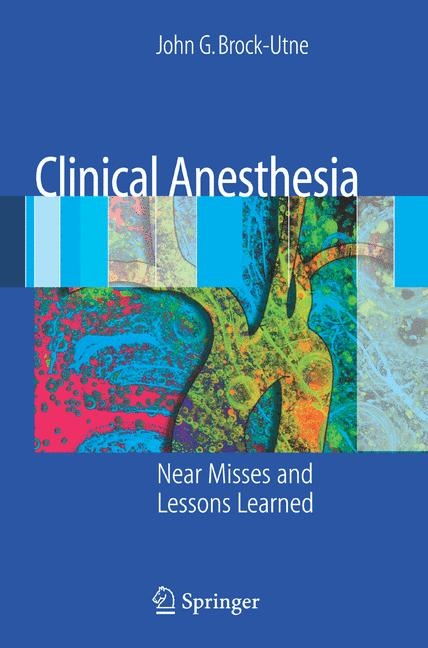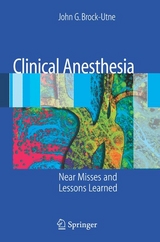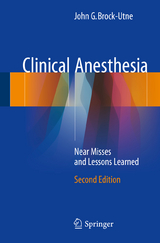Clinical Anesthesia
Springer-Verlag New York Inc.
978-0-387-72519-2 (ISBN)
- Titel erscheint in neuer Auflage
- Artikel merken
- Describes dozens of actual near-miss cases, and how they were resolved
- Helps readers anticipate and successfully manage both common and unusual complications in their own practices
- Extremely useful as preparation for the ABA oral exam
Compiled from the author's decades of practice in major metropolitan hospitals, this collection of cases offers an excellent review of problems - and the solutions all anesthesiologists should know. The cases are wonderfully succinct, with the problem described on one page and the solution on the next.
Residents, fellows, and practising certified registered nurse anesthetists will benefit from the retelling of these actual near misses, the solutions chosen at the time, and a retrospective analysis of those solutions that includes tips for how the problems could have been avoided altogether or resolved differently.
An excellent study aid for the American Board of Anesthesiology oral exam and a useful teaching tool for faculty, since near misses such as these are relatively rare and other than reading about them, there really is no way to be prepared to successfully manage such crises. As such, even experienced anesthesiologists and CRNAs will find this to be a worthy purchase.
John Brock-Utne is currently a professor of Anesthesia and the Associate Director of the Anesthesia Residency Program at Stanford University Medical School. He has written over 200 peer reviewed articles and 370 abstracts and letters, including the book Near Misses in Pediatric Anesthesia.
No fiberoptic intubation system: a potential problem?.- Is the patient extubated?.- A strange computerized ECG interpretation.- Fractured neck of femur in an elderly patient.- Spinal anesthetic that wears off before surgery ends.- Understanding DNR/DNI orders.- Burn prevention in the operating room.- Inguinal hernia repair in a diabetic patient.- Case of the hidden IV.- Ideal pulse oximeter placement.- Awake craniotomy with language mapping.- Gum elastic bougie to facilitate intubation.- External vaporizer leak during anesthesia.- Manual ventilation by a single operator: Omar’s slave for difficult positioning.- Life threatening arrhythmia in an infant.- Tongue ring: Anesthetic risks and potential complications.- Hasty C-arm positioning: A recipe for disaster.- Inability to remove a nasogastric tube.- An unusual cause of difficult tracheal intubation: Religious beliefs and customs.- Pulmonary edema following abdominal laparoscopy.- Difficult laryngeal mask airway placement: A possible solution.- Postoperative airway complication following sinus surgery.- Investigating an unusual capnograph tracing: Check your connections.- Endotracheal intubation for atransjugular intrahepatic porto-systemic shunt (TIPS) procedure.- Tracheostomy by an anesthesiologist: Be prepared.- General anesthesia for a patient with a difficult airway and a full stomach.- Jehovah’s Witness and a potentially bloody operation.- Intraoperative insufflation of the stomach.- Sudden intraoperative hypotension.- Overestimation of blood pressure from an arterial pressure line.- Severe decrease in lung compliance during a code blue.- Shortening postoperative recovery time after an epidural: Is it possible? .- Difficult airway in an under-equipped setting.- Delayed cutaneous fluid leak following removal of an epidural catheter.- Traumatic hemothorax and same-side central venous access.- An apparent single abdominal knife wound: Check for other wounds.- A draw-over vaporizer with a non-rebreathing circuit.- Unexpected intraoperative "oozing".- Central venous access and the obese patient.- Taking over for a colleague: Check the facts and know the medications.- Intraoperative epidural catheter malfunction.- Breathing difficulties after an ECT.- White clumps in the blood sample from an arterial line: Beware of heparin-induced thrombocytopenia.- Anesthesia for a surgeon who has previously lost his privileges.- Airway obstruction in a prone patient.- Expected length of case: A question you should always ask.- Postoperative vocal cord paralysis.- Substance abuse by a colleague: a serious problem.- A leaking endotracheal tube in a prone patient.- Lessons from the field: Unusual problems require unusual solutions in impossible situations.- Avoiding air embolism during administration of albumin.- Trouble-shooting leaks: A loud "pop" intraoperatively and now you can’t ventilate.- Postoperative median nerve injury.- Patient in a halo: Intraoperative adjustments change your view and access.- Now or never: Developing professional judgment.- General anesthesia in a patient with chronic amphetamine use.- What’s wrong with this picture? Left-handed instrumentation.- The one eyed patient.- A near tragedy.- Robot assisted surgery: a word of caution.- An airway mergency in an out of hospital surgical office.- Another use for the nerve stimulator
| Erscheint lt. Verlag | 6.4.2011 |
|---|---|
| Zusatzinfo | 30 black & white illustrations, 10 black & white tables |
| Verlagsort | New York, NY |
| Sprache | englisch |
| Maße | 156 x 234 mm |
| Gewicht | 580 g |
| Einbandart | Paperback |
| Themenwelt | Medizin / Pharmazie ► Medizinische Fachgebiete ► Anästhesie |
| Medizin / Pharmazie ► Medizinische Fachgebiete ► Intensivmedizin | |
| ISBN-10 | 0-387-72519-9 / 0387725199 |
| ISBN-13 | 978-0-387-72519-2 / 9780387725192 |
| Zustand | Neuware |
| Haben Sie eine Frage zum Produkt? |
aus dem Bereich





